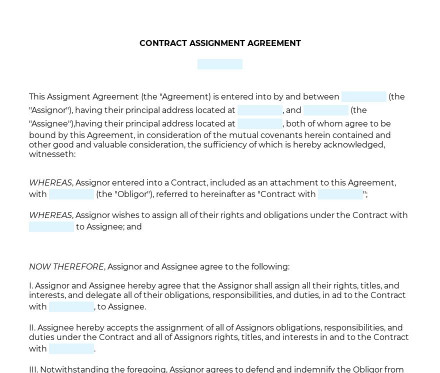 Contract Assignment Agreement preview" />
Contract Assignment Agreement preview" />The transfer of rights and obligations under the original contract from a party known as the Assignor to another party known as the Assignee is subject to this Contract Assignment Agreement.
Complete the wizard & download the document Contract Assignment Agreement preview" />
Contract Assignment Agreement preview" />
The transfer of rights and obligations under the original contract from a party known as the Assignor to another party known as the Assignee is subject to this Contract Assignment Agreement. The party from the original contract called the Assignor can use this document to assign their rights under the original contract to the Assignee. He can also delegate their duties under the initial agreement to that Assignee. For example, a handmaid who was hired to clean her client's home but is no longer able to due to a move could assign their rights and responsibilities under the original service contract to a new handmaid.
You fill out a form. The document is created before your eyes as you respond to the questions.
At the end, you receive it in Word and PDF formats. You can modify it and reuse it.
Before using this document, make sure that the assignment has all the necessary permissions from another party called the Obligor. The agreement contains important information about the identity of all the parties, the duration of the original agreement, and whether the Obligor's consent is required before the original agreement can be granted. If consent is required, indicate the form in which the Assignor obtained it and when.
If the Agreement involves a transfer of the land between parties, the document will include information on where the property is located, as well as for the document to be recorded in the county's official records, and the notary page customized for the land's location so that the material can be notarized.
The completed document should be signed, dated, and all Parties should keep a copy by themselves. If the Agreement concerns the transfer of the land, the Agreement is then notarized and taken to be recorded so that there is an official record that the property was transferred.
Common law in the Second Restatement of Contacts (the Restatement) governs the assignment of contracts that include the provision of services. The Restatement is a non-binding authority in all of U.S common law in the area of contracts and commercial transactions. Though the Restatement is non-binding, it is frequently cited by courts in explaining their reasoning in interpreting contractual disputes.